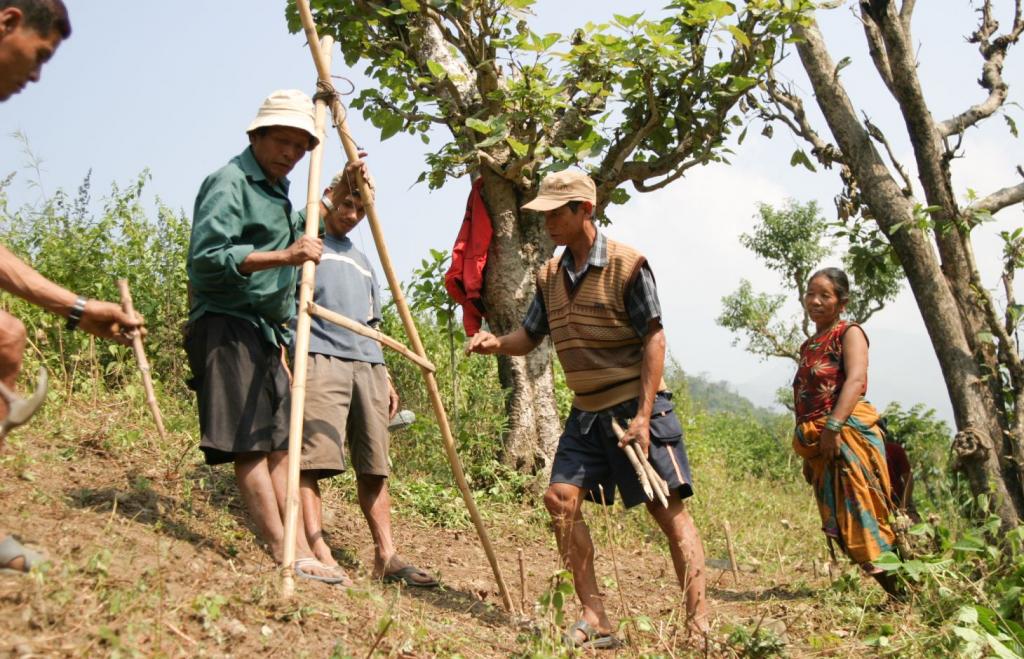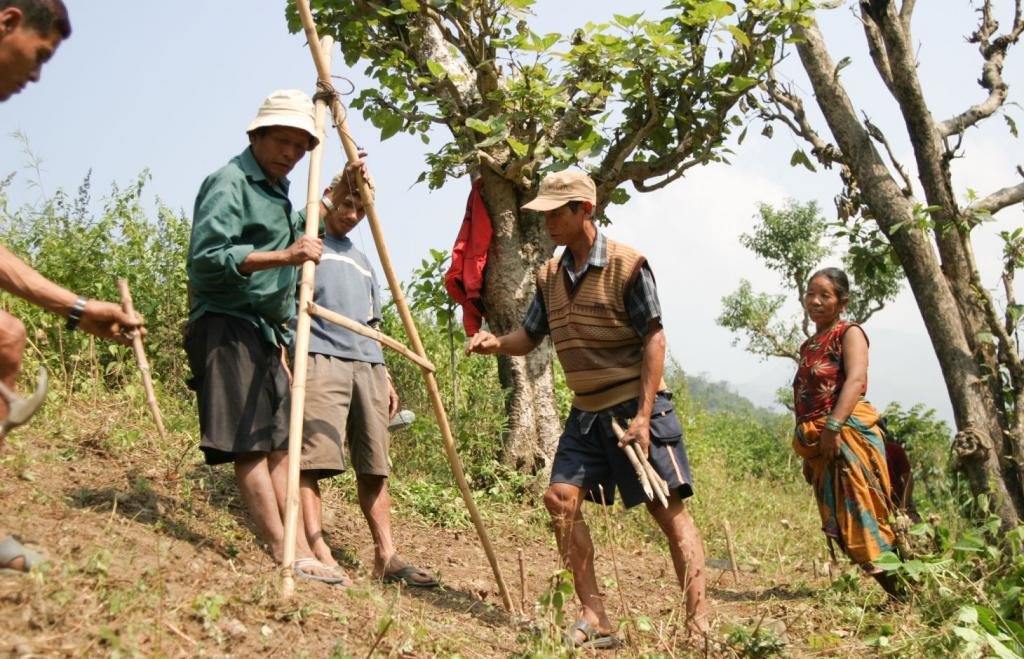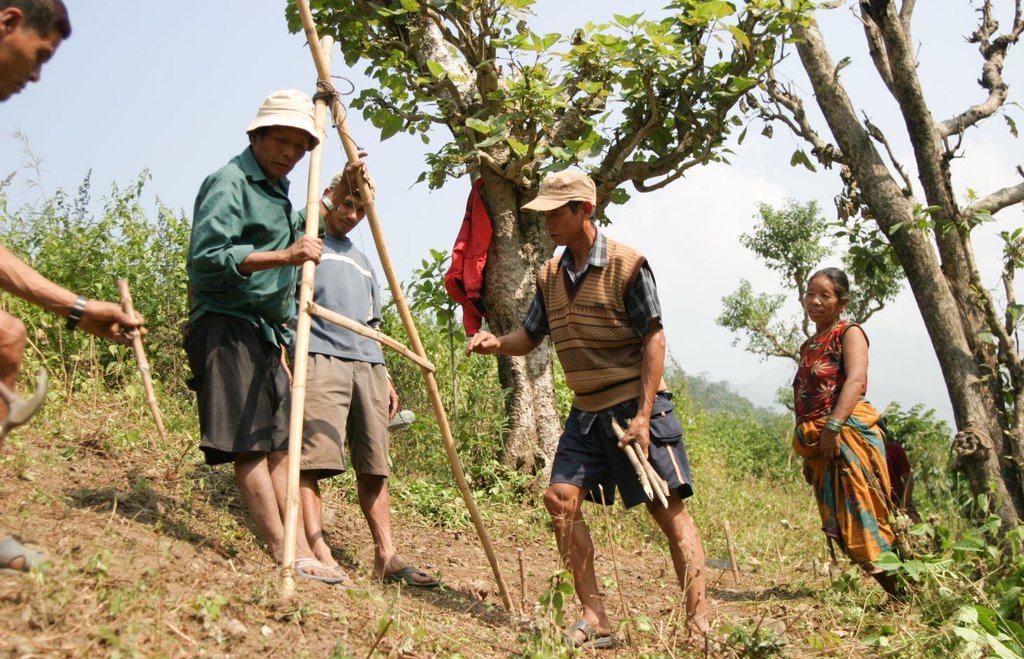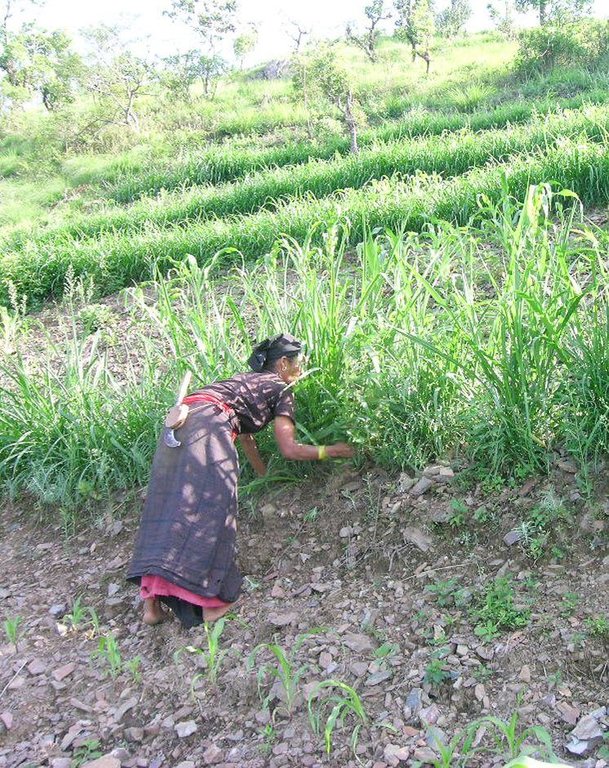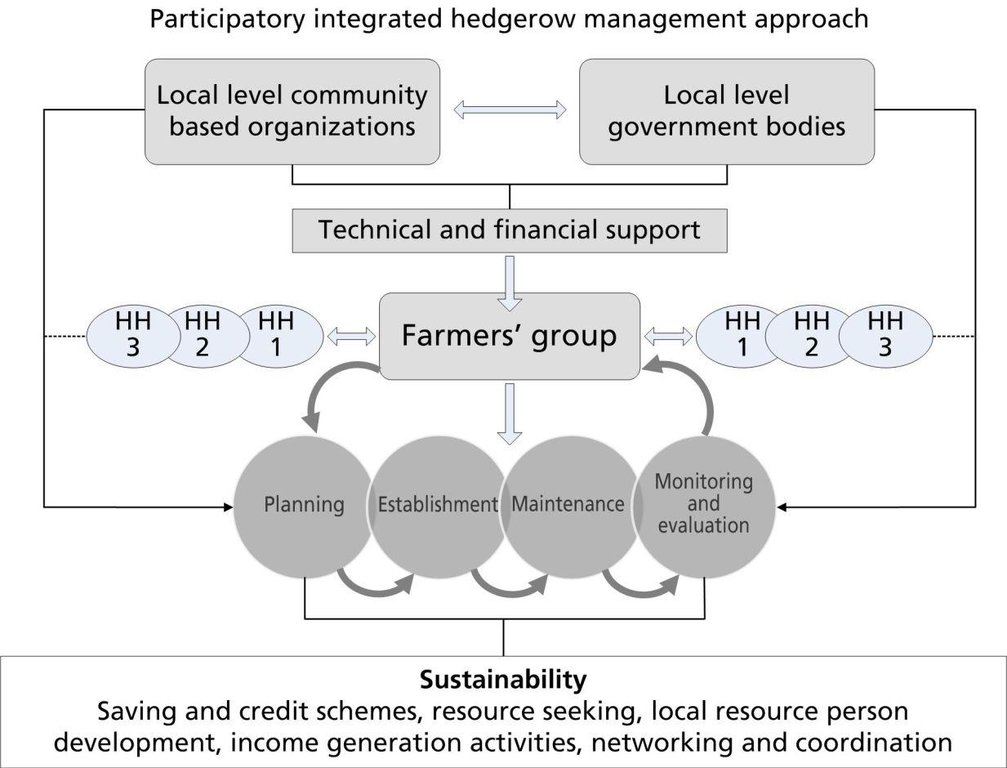Participatory hedgerow management [ប្រទេសនេប៉ាល់]
- ការបង្កើត៖
- បច្ចុប្បន្នភាព
- អ្នកចងក្រង៖ Shreedip Sigdel
- អ្នកកែសម្រួល៖ –
- អ្នកត្រួតពិនិត្យ Fabian Ottiger
Sahabhagitamulak ghasehar bewasthapan (Main Contributor: Gyanbandhu Sharma, LI-BIRD)
approaches_2530 - ប្រទេសនេប៉ាល់
ពិនិត្យមើលគ្រប់ផ្នែក
ពង្រីកមើលទាំងអស់ បង្រួមទាំងអស់1. ព័ត៌មានទូទៅ
1.2 ព័ត៌មានលម្អិតពីបុគ្គលសំខាន់ៗ និងស្ថាប័នដែលចូលរួមក្នុងការវាយតម្លៃ និងចងក្រងឯកសារនៃវិធីសាស្ត្រផ្សព្វផ្សាយ
អ្នកជំនាញឯកទេស SLM:
ឈ្មោះអង្គភាពមួយ (ច្រើន) ដែលបានចងក្រងឯកសារ/ វាយតម្លៃលើវិធីសាស្ត្រផ្សព្វផ្សាយ (បើទាក់ទង)
Local Initiatives for Biodiversity, Research, and Development (LI-BIRD) - ប្រទេសនេប៉ាល់ឈ្មោះអង្គភាពមួយ (ច្រើន) ដែលបានចងក្រងឯកសារ/ វាយតម្លៃលើវិធីសាស្ត្រផ្សព្វផ្សាយ (បើទាក់ទង)
ICIMOD International Centre for Integrated Mountain Development (ICIMOD) - ប្រទេសនេប៉ាល់1.3 លក្ខខណ្ឌទាក់ទងទៅនឹងការប្រើប្រាស់ទិន្នន័យដែលបានចងក្រងតាមរយៈវ៉ូខេត
តើពេលណាដែលទិន្នន័យបានចងក្រង (នៅទីវាល)?
01/03/2013
អ្នកចងក្រង និង(បុគ្គលសំខាន់ៗ)យល់ព្រមទទួលយកនូវលក្ខខណ្ឌនានាទាក់ទងទៅនឹងការប្រើប្រាស់ទិន្នន័យដែលបានចងក្រងតាមរយៈ វ៉ូខេត:
បាទ/ចា៎
1.4 ការយោងមួយ (ច្រើន) ទៅលើ (កម្រង) បញ្ជីសំណួរនៃបច្ចេកទេស SLM
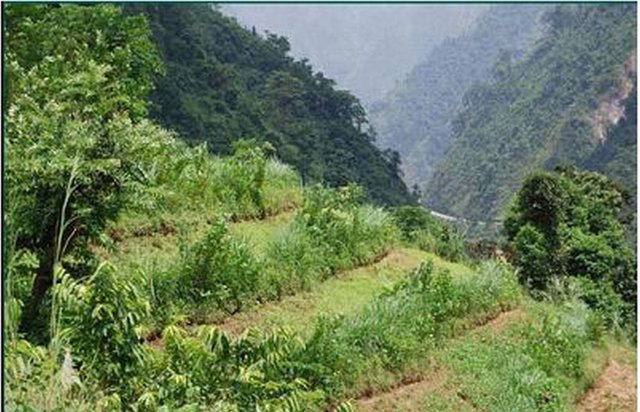
Hedgerow technology [ប្រទេសនេប៉ាល់]
A technology that uses hedgerows to help establish terraces on sloping land; farmers learn improved methods to manage a cultivation practice that stabilizes the soil, enhances food production, and adds to on-farm cash income.
- អ្នកចងក្រង៖ Shreedip Sigdel
2. ការពណ៌នាអំពីវិធីសាស្ត្រផ្សព្វផ្សាយ SLM
2.1 ពណ៌នាសង្ខេបខ្លីពីវិធីសាស្ត្រផ្សព្វផ្សាយ
Hedgerow technology can be introduced through the joint participation of farmers, scientists, and related stakeholders. The whole community works together at all stages, including designing, planning, implementation, monitoring and evaluation, and scaling up.
2.2 ពណ៌នាលម្អិតពិវិធីសាស្ត្រផ្សព្វផ្សាយ
ពណ៌នាលម្អិតពិវិធីសាស្ត្រផ្សព្វផ្សាយ:
Aims / objectives: Communities can establish better hedgerows by supplementing the traditional knowledge that they have employed for generations with scientific knowledge through a participatory process where both groups are involved in every step of planning, designing, and implementation. This approach recognizes the validity of the local knowledge that farmers have about their land and supplements it with scientific techniques to facilitate the implementation of methods which will yield better results sooner.
Methods: Hedgerow technology can be implemented by forming farmers' groups and using a participatory approach. This technology has the potential to be scaled up and applied on a broader scale. The steps for sharing labour and know-how to establish hedgerows can be summarized as follows:
• Capacity is strengthened through discussions with technical persons.
• Farmers, technical persons, and related stakeholders work together to come up with plans that make the best use of both the farmers’ indigenous knowledge on how to form hedgerows and their understanding of the landscape, and scientific knowledge, for designing and planning.
• The hedgerows are established by the farmers as per the consensual plan.
• Some farmers are designated to periodically inspect the hedgerows and to perform maintenance as needed.
• The technology is scaled up by farmers who disseminate the learning to other farmers through extension and knowledge sharing at different fora.
Stages of implementation: Farmers, technical persons, and related stakeholders were all involved at every stage. In addition, LI-BIRD, local community-based organizations, and other related stakeholders such as the district forest office and the district agriculture office were on hand to support the farmers' group by offering technical and financial resources. The farmers' groups had a vested interest in this approach and demonstrated their commitment by: generating funds from a savings and credit scheme and conducting income generating activities. They also worked to establish effective linkages and to coordinate with related stakeholders to obtain resources which would ensure that the group would be self-reliant in the long run. The involvement of a wide range of participants will ensure that the technology is not only effective but that it is also sustainable. Moreover, when neighbouring communities see how successful this approach can be, it is hoped that they also will adopt the technology.
2.3 រូបភាពនៃវិធីសាស្ត្រផ្សព្វផ្សាយ
2.5 ប្រទេស/តំបន់/ទីតាំងកន្លែង ដែលវិធីសាស្ត្រផ្សព្វផ្សាយត្រូវបានអនុវត្តន៍
ប្រទេស:
ប្រទេសនេប៉ាល់
បញ្ជាក់បន្ថែមពីលក្ខណៈនៃទីតាំង:
Gorkha, Tanahu District
2.7 ប្រភេទនៃវិធីសាស្ត្រផ្សព្វផ្សាយ
- ផ្អែកលើគម្រោង/កម្មវិធី
2.8 គោលបំណង/ទិសដៅសំខាន់នៃវិធីសាស្ត្រផ្សព្វផ្សាយ
The Approach focused mainly on SLM with other activities (Income generation)
The objective of this approach was to introduce the technology through participatory planning, designing, and implementation by integrating farmers’ knowledge and experiences in the process.
The SLM Approach addressed the following problems: This approach addressed a few of the major problems in the area. The outstanding problems were:
• poor technical knowledge,
• lack of group efforts,
• lack of cash for investment,
• poor access to service providers,
• inadequate use made of farmers' traditional knowledge,
• inadequate knowledge resources, and
• poverty and poor social cohesiveness.
2.9 លក្ខខណ្ឌអនុញ្ញាត ឬរារាំងការអនុវត្តន៍បច្ចេកទេសដែលស្ថិតនៅក្រោមវិធីសាស្រ្តផ្សព្វផ្សាយ
ភាពអាចរកបាននៃធនធានហិរញ្ញវត្ថុ និងសេវាកម្ម
- រារាំង
Farmers had insufficient financial resources to implement the technology
Treatment through the SLM Approach: Farmers learned how to apply for resources from different related stakeholders and they also learned how to generate cash from their own group using savings and credit schemes.
បរិបទនៃស្ថាប័ន
- រារាំង
Farmers had no formal institutional mechanisms and also had no capacity to run their institutions
Treatment through the SLM Approach: Farmers learned how to form a formal group and also improved their capacity to run their institutions
ក្របខណ្ឌច្បាប់ (សិទ្ធិកាន់កាប់ដីធ្លី កម្មសិទ្ធីប្រើប្រាស់ដីនិងទឹក)
- រារាំង
The existing land ownership, land use rights / water rights hindered a little the approach implementation
ចំណេះដឹងស្តីពី SLM និងការទទួលបានការគាំទ្រផ្នែកបច្ចេកទេស
- រារាំង
Farmers had low technical knowledge
Treatment through the SLM Approach: Farmers shared their know-how and also learned from scientists, other farmers and related stakeholders
3. ការចូលរួម និងតួនាទីរបស់ភាគីពាក់ព័ន្ធ
3.1 អ្នកពាក់ព័ន្ធដែលបានចូលរួមក្នុងវិធីសាស្ត្រផ្សព្វផ្សាយ និងតួនាទីរបស់ពួកគេ
- អ្នកប្រើប្រាស់ដីក្នុងតំបន់/សហគមន៍
- អ្នកឯកទេសគ្រប់គ្រងដីប្រកបដោយចីរភាព/ទីប្រឹក្សាបច្ចេកទេសកសិកម្ម
- អង្គការក្រៅរដ្ឋាភិបាល
LI-BIRD
- រដ្ឋាភិបាលថ្នាក់មូលដ្ឋាន
- រដ្ឋាភិបាលថ្នាក់ជាតិ (អ្នករៀបចំផែនការ អ្នកសម្រេចចិត្ត)
ប្រសិនមានភាគីពាក់ព័ន្ធច្រើនចូលរួមសូមចង្អុលបង្ហាញភ្នាក់ងារដែលនាំមុខគេ:
Specialists and land users. During the design process, specialists organized on-farm visits and exposure visits. The plan was prepared jointly by the land users and the specialists who used each others' expertise.
3.2 ការចូលរួមរបស់អ្នកប្រើប្រាស់ដីក្នុងតំបន់/ សហគមន៍ក្នុងតំបន់ក្នុងដំណាក់កាលផ្សេងគ្នានៃវិធីសាស្រ្តផ្សព្វផ្សាយ
| ការចូលរួមរបស់អ្នកប្រើប្រាស់ដីក្នុងតំបន់/សហគមន៍ក្នុងតំបន់ | សូមបញ្ជាក់នរណាត្រូវបានចូលរួម ព្រមទាំងពណ៌នាសកម្មភាពទាំងនោះ | |
|---|---|---|
| ការចាប់ផ្តើម/ការលើកទឹកចិត្ត | អសកម្ម | At the beginning, the land users were mostly passive because they lacked information on sloping land management. |
| ការរៀបចំផែនការ | អន្តរកម្ម | Land users were actively involved in the planning stage and they incorporated feedback from other stakeholders to finalize the action plan. During this phase they also prepared the land and the materials, and recruited the resource person needed to implement the technology |
| ការអនុវត្តន៍ | គំនិតផ្តួចផ្តើមដោយខ្ឡួនឯង | Land users were involved in the implementation phase mobilizing their group members and shared the new technical knowledge that they had acquired. |
| ការត្រួតពិនិត្យ និងវាយតម្លៃ | អន្តរកម្ម | Land users and other stakeholders remained actively involved throughout the different stages of monitoring and evaluation. |
| Research | ការគាំទ្រពីខាងក្រៅ | Land users were actively involved in research work to test and validate the approach. |
3.3 គំនូសបំព្រួញ (ប្រសិនបើមាន)
3.4 ការសម្រេចចិត្តលើការជ្រើសរើសបច្ចេកទេស SLM
សូមបញ្ជាក់តើអ្នកណាជាអ្នកបានសម្រេចចិត្តក្នុងការជ្រើសរើសបច្ចេកទេសដើម្បីយកមកអនុវត្តន៍:
- អ្នកប្រើប្រាស់ដី ដោយមានការគាំទ្រពីអ្នកជំនាញឯកទេស SLM
ចូរពន្យល់:
Both farmers and specialist were involved in on-farm visits to assess the condition of the land; farmers attended seminars to acquire new knowledge and they also used this opportunity to share their own knowledge. Farmers and specialists together selected the technology.
Decisions on the method of implementing the SLM Technology were made by mainly by land users supported by SLM specialists
4. ជំនួយបច្ចេកទេស ការកសាងសមត្ថភាព និងការគ្រប់គ្រងចំណេះដឹង
4.1 ការកសាងសមត្ថភាព/ បណ្តុះបណ្តាល
តើវគ្គបណ្តុះបណ្តាលបានផ្តល់ឱ្យអ្នកប្រើប្រាស់ដី/អ្នកពាក់ព័ន្ធផ្សេងៗទៀតដែរឬទេ?
បាទ/ចា៎
សូមបញ្ជាក់តើអ្នកណាត្រូវបានបណ្តុះបណ្តាល:
- អ្នកប្រើប្រាស់ដី
- បុគ្គលិកចុះទីវាល/អ្នកផ្តល់ប្រឹក្សាយោបល់
- Local Resource Person
ទម្រង់នៃការបណ្តុះបណ្តាល:
- ពីកសិករទីកសិករ
- ទីតាំងបង្ហាញ
ប្រធានបទបណ្តុះបណ្តាល:
This approach provided training on hedgerow technology and group mobilization to enhance the capacity of land users, field staff, and local resource persons. Site visits to the demonstration areas were also organized for the land users.
4.2 សេវាផ្តល់ប្រឹក្សាយោបល់
តើអ្នកប្រើប្រាស់ដីបានទទួលនូវសេវាផ្តល់ប្រឹក្សាដែរ ឬទេ?
បាទ/ចា៎
សូមបញ្ជាក់ប្រសិនបើសេវាកម្មប្រឹក្សាយោបល់ត្រូវបានផ្តល់ឱ្យ:
- នៅមជ្ឈមណ្ឌលជាអចិន្ត្រៃ
ពណ៌នា/ពន្យល់:
Name of method used for advisory service: Group Mobilization Method; Key elements: networking and coordination of farmers' groups with district level line agencies such as the district forest office, the district agriculture office, the district livestock office, and other relevant stakeholders for learning and sharing of information.
4.3 ការពង្រឹងសមត្ថភាពស្ថាប័ន (ការអភិរឌ្ឍន៍អង្គភាព)
តើស្ថាប័នទាំងអស់ត្រូវបានបង្កើតឡើង ឬពង្រឹងសមត្ថភាពតាមរយៈវិធីសាស្ត្រផ្សព្វផ្សាយដែរ ឬទេ?
- បាទ/ច៎ា តិចតួច
សូមបញ្ជាក់ថាតើស្ថាប័នត្រូវបានពង្រឹង ឬបង្កើតឡើងនៅត្រឹមកម្រិតណា(ច្រើន)?
- ថ្នាក់មូលដ្ឋាន
សូមបញ្ជាក់ប្រភេទនៃការគាំទ្រ:
- ការកសាងសមត្ថភាព/ បណ្តុះបណ្តាល
សូមផ្តល់ព័ត៌មានបន្ថែមទៀតឱ្យបានលម្អិត:
Trainings and sessions on capacity building were provided to the land users
4.4 ការត្រួតពិនិត្យ និងវាយតម្លៃ
តើការត្រួតពិនិត្យ និងវាយតម្លៃគឺជាផ្នែកមួយនៃវិធីសាស្ត្រដែរឬទេ?
បាទ/ចា៎
មតិយោបល់:
bio-physical aspects were regular monitored by project staff, land users through observations; indicators: The land users and project staff made regular observations of sediment deposition rates after the intervention.
technical aspects were regular monitored by project staff, land users through observations; indicators: The land users and project staff made regular observations on the formation of terraces and control of erosion.
socio-cultural aspects were regular monitored by project staff, land users through observations; indicators: The land users and project staff regularly observed sociocultural impacts
economic / production aspects were regular monitored by project staff, land users through observations; indicators: The land users and project staff regularly observed the extent to which the income of the land users changed.
area treated aspects were regular monitored by government, land users through measurements; indicators: The land users and government staff monitored the coverage of the technology.
no. of land users involved aspects were regular monitored by project staff, land users through observations; indicators: Regular observations were made by the land users and project staff on how many land users were adopting the technology.
management of Approach aspects were regular monitored by project staff, land users through observations; indicators: The land users and project staff regularly observed how well the group functioned together and how well they linked with stakeholders
There were few changes in the Approach as a result of monitoring and evaluation: Monitoring brought few changes; farmers used the information gathered during monitoring of on-farm demonstration to help them select the species they preferred but the technology remained the same.
There were no changes in the Technology as a result of monitoring and evaluation
4.5 ការស្រាវជ្រាវ
តើការស្រាវជ្រាវ គឺជាផ្នែកមួយនៃវិធីសាស្រ្តដែរឬទេ?
បាទ/ចា៎
បញ្ជាក់ប្រធានបទ:
- បច្ចេកវិទ្យា
សូមផ្តល់ព័ត៌មានបន្ថែមទៀតឱ្យបានលម្អិត និងចង្អុលបង្ហាញនរណាដែលបានធ្វើការស្រាវជ្រាវ:
On-farm technical research was a part of the approach applied by land users, specialists, and relevant stakeholders who were involved in hedgerow technology trials.
Research was carried out on-farm
5. ថវិកា និងសម្ភារៈឧបត្ថម្ភពីខាងក្រៅ
5.1 ថវិកាប្រចាំឆ្នាំសម្រាប់ផ្សព្វផ្សាយ SLM
មតិយោបល់ (ឧ. ប្រភពសំខាន់នៃមូលនិធិ/ម្ចាស់ជំនួយចំបង):
Approach costs were met by the following donors: national non-government: 20.0%; local government (district, county, municipality, village etc): 10.0%; local community / land user(s): 70.0%
5.2 ការគាំទ្រផ្នែកហិរញ្ញវត្ថុ / សម្ភារៈដែលបានផ្តល់ទៅឱ្យអ្នកប្រើប្រាស់ដី
តើអ្នកប្រើប្រាស់ដីបានទទួលការគាំទ្រផ្នែកហិរញ្ញវត្ថ/សម្ភារៈសម្រាប់ការអនុវត្តន៍បច្ចេកទេសដែរឬទេ:
បាទ/ចា៎
ប្រសិនបាទ/ច៎ា សូមបញ្ជាក់ប្រភេទ(ច្រើន)នៃការគាំទ្រ លក្ខខណ្ឌ និងអ្នកផ្តល់ឱ្យ(ច្រើន):
LI-BIRD provided some support.
5.3 សូមបញ្ជាក់ពីធាតុចូលត្រូវបានផ្តល់បដិភាគ (រួមទាំងកម្លាំងពលកម្ម)
ប្រសិនបើកម្លាំងពលកម្មធ្វើដោយអ្នកប្រើប្រាស់ដី តើវាជាធាតុចូលដ៏សំខាន់មួយដែរ ឬទេ:
- ដោយស្ម័គ្រចិត្ត
5.4 ឥណទាន
តើឥណទានដែលបានផ្តល់នៅក្រោមវិធីសាស្ត្រផ្សព្វផ្សាយសម្រាប់សកម្មភាព SLM នេះយ៉ាងដូចម្តេច?
ទេ
6. ការវិភាគរកផលប៉ះពាល់ និងសេចក្តីសន្និដ្ឋាន
6.1 ផលប៉ះពាល់នៃវិធីសាស្ត្រផ្សព្វផ្សាយ
តើវិធីសាស្ត្រផ្សព្វផ្សាយជួយអ្នកប្រើប្រាស់ដីដើម្បីអនុវត្តន៍ និងថែទាំបច្ចេកទេស SLM?
- ទេ
- បាទ/ច៎ា បន្តិចបន្តួច
- បាទ/ច៎ា ជាមធ្យម
- បាទ/ច៎ា បានខ្លាំង
This approach helped to stabilize the fragile hill slopes.
តើវិធីសាស្ត្រផ្សព្វផ្សាយនេះផ្តល់សិទ្ធិអំណាចដល់សង្គមនិងសេដ្ឋកិច្ចដែលក្រុមមិនទទួលបានផលប្រយោជន៍?
- ទេ
- បាទ/ច៎ា បន្តិចបន្តួច
- បាទ/ច៎ា ជាមធ្យម
- បាទ/ច៎ា បានខ្លាំង
The capacity of marginal ethnic groups increased; they learned how local institutions function and felt empowered to seek resources from their service providers.
Did other land users / projects adopt the Approach?
- ទេ
- បាទ/ច៎ា បន្តិចបន្តួច
- បាទ/ច៎ា ជាមធ្យម
- បាទ/ច៎ា បានខ្លាំង
This approach was adopted by adjoining villagers and scaled up gradually in Dhading, Chitwan, Nawalparasi, and Makwanpur Districts. According to preliminary information, at least 450 households have now adopted this approach for sustainable land management.
Did the Approach lead to improved livelihoods / human well-being?
- ទេ
- បាទ/ច៎ា បន្តិចបន្តួច
- បាទ/ច៎ា ជាមធ្យម
- បាទ/ច៎ា បានខ្លាំង
This approach helped to improve the livelihood status of the land users by helping to diversify their options for income generation and skills development.
Did the Approach help to alleviate poverty?
- ទេ
- បាទ/ច៎ា បន្តិចបន្តួច
- បាទ/ច៎ា ជាមធ្យម
- បាទ/ច៎ា បានខ្លាំង
After the implementation of this approach, land users could earn cash income and learned how to increase their capacity to implement income generating activities which would enhance their livelihoods.
6.2 ការលើកទឹកចិត្តចម្បងៗរបស់អ្នកប្រើប្រាស់ដីសម្រាប់ការអនុវត្តបច្ចេកទេស SLM
6.3 សកម្មភាពផ្សព្វផ្សាយដែលប្រកបដោយចីរភាព
តើអ្នកប្រើប្រាស់ដីអាចធ្វើឱ្យមានចីរភាពនូវអ្វីដែលត្រូវបានអនុវត្តន៍តាមរយៈវិធីសាស្ត្រផ្សព្វផ្សាយដែរឬទេ(ដោយពុំមានការគាំទ្រពីអ្នកខាងក្រៅ)?
- មិនប្រាកដ
ប្រសិន ទេ ឬមិនប្រាកដសូមបញ្ជាក់ និងពន្យល់:
Individual land users were enthusiastic to implement the approach and to take it further. Land users who are shifting cultivators, and who typically have no land ownership, are slower to embrace the approach.
6.4 ភាពខ្លាំង/ គុណសម្បត្តិនៃវិធីសាស្ត្រផ្សព្វផ្សាយ
| ភាពខ្លាំង/ គុណសម្បត្តិ/ ឱកាស ទស្សនៈរបស់បុគ្គលសំខាន់ៗ |
|---|
| Sustained capacity building (How to sustain/ enhance this strength: Continue to build strong links and coordinate with government line agencies) |
| Improved access to services providers helped to enhance their capacity to cope with adverse conditions (How to sustain/ enhance this strength: Continue to build and maintain contact with government line agencies) |
| Local institutions were strengthened (How to sustain/ enhance this strength: Established formal institutions and help to sustain them) |
| Land users actively participated and took ownership (How to sustain/ enhance this strength: Continue capacity building and training. At present the government is initiating programmes with leasehold forest groups in Gorkha and Tanahu Districts that encourages the establishment hedgerows è Work to mainstream the approach within government programmes) |
| Collaboration helped land users to sustain their efforts (How to sustain/ enhance this strength: Continue to build a sense of community between land users) |
6.5 ភាពខ្សោយ/ គុណវិបត្តិនៃវិធីសាស្ត្រ និងរកដំណោះស្រាយ
| ភាពខ្សោយ/ គុណវិបត្តិ/ ហានិភ័យក្នុងទស្សនៈរបស់បុគ្គលសំខាន់ៗ | តើបច្ចេកទេសទាំងនោះបានដោះស្រាយបញ្ហាដូចម្តេច? |
|---|---|
| Difficult to develop common understanding | Organized regular learning and sharing to develop common understanding |
|
Farmers have only a limited understanding of the skills needed |
Continue to strengthen farmers' groups and continue to mobilize through sharing and learning |
| The approach is resource intensive. | Promote savings and credit schemes with farmers' groups. Mobilize farmers' groups so that they can petition other groups and line agencies for resources. |
| Time consuming | Work with land users to improve their time management and their ability to plan future activities and delegate responsibilities |
| Few farmers participated during the initial stages | Conduct awareness raising activities and promote activities that give some tangible benefits in the short term. |
7. ឯកសារយោង និងវេបសាយ
7.1 វិធីសាស្ត្រ/ ប្រភពនៃព័ត៌មាន
- តាមការចុះទីវាល ការស្រាវជ្រាវនៅទីវាល
- ការសម្ភាសន៍ជាមួយអ្នកប្រើប្រាស់ដី
7.2 ឯកសារយោងដែលបានចេញផ្សាយ
ចំណងជើង អ្នកនិពន្ធ ឆ្នាំ ISBN:
Building on partnership approaches in participatory identification of integrated agricultural technological packages suitable for sloping land areas (unpublished), Regmi, BR; Aryal, KP; Shrestha, PK; Tamang, BB (2003)
មានប្រភពមកពីណា? ថ្លៃដើមប៉ុន្មាន?
LI-BIRD
ការតភ្ជាប់ និងម៉ូឌុល
ពង្រីកមើលទាំងអស់ បង្រួមទាំងអស់ការតភ្ជាប់

Hedgerow technology [ប្រទេសនេប៉ាល់]
A technology that uses hedgerows to help establish terraces on sloping land; farmers learn improved methods to manage a cultivation practice that stabilizes the soil, enhances food production, and adds to on-farm cash income.
- អ្នកចងក្រង៖ Shreedip Sigdel
ម៉ូឌុល
គ្មានម៉ូឌុល


